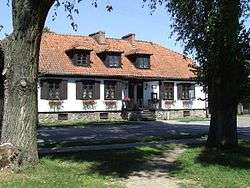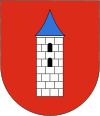Bieżuń
| Bieżuń | ||
|---|---|---|
|
Museum | ||
| ||
 Bieżuń | ||
| Coordinates: 52°57′N 19°53′E / 52.950°N 19.883°E | ||
| Country |
| |
| Voivodeship | Masovian | |
| County | Żuromin | |
| Gmina | Bieżuń | |
| Town rights | 1409-1869, 1994 | |
| Government | ||
| • Mayor | Ewa Łubińska | |
| Area | ||
| • Total | 12.07 km2 (4.66 sq mi) | |
| Population (2006) | ||
| • Total | 1,874 | |
| • Density | 160/km2 (400/sq mi) | |
| Time zone | CET (UTC+1) | |
| • Summer (DST) | CEST (UTC+2) | |
| Postal code | 09-320 | |
| Area code(s) | +48 23 | |
| Car plates | WZU | |
| Website | http://www.biezun.pl | |
Bieżuń [ˈbʲɛʐuɲ] is a town in Żuromin County, Masovian Voivodeship, Poland, with 1,903 inhabitants (2004) on the Wkra River. Jedrzej of Golczew, castellan of Płock, established the town at the end of the 14th century. Prince Siemowit IV, Duke of Masovia granted the city rights charter in 1406 and in 1869, during the Russia's occupation, the town lost its city rights until 1994. Prior to the Deluge the town was famous and had a strong castle, but it was destroyed during that war. Polish Crown Kanclerz Andrzej Zamoyski was born there and lived in the palace he built while working on his code of civil laws known as Zbiór praw sądowych During Zamojski's residency there, in 1767, Polish-Lithuanian Commonwealth king Stanisław August Poniatowski granted the renewal of the town charter under the Magdeburg rights. After the Third of Partitions of Poland town fell into the Prussia's domain, then during the War of the Fourth Coalition there was a small pitched battled between the Napoleonic troops and the Prussians known as battle of Bieżuń, it was a French victory and took place on December 21–23, 1806. Between 1807-15 it was part of Duchy of Warsaw, then under the Russian dominion until 1918.
References
- Słownik geograficzny Królestwa Polskiego i innych krajów słowiańskich, Tom I, page224-225.
External links
- Official town and commune webpage
- Jewish Community in Bieżuń on Virtual Shtetl
Coordinates: 52°57′25″N 19°53′15″E / 52.95694°N 19.88750°E

